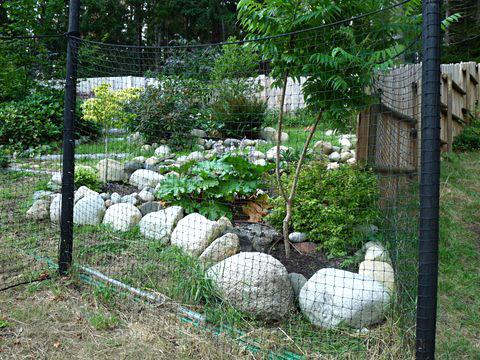Anyone who has a garden knows how frustrating it is to work day in and day out only to find that deer have eaten your tomatoes, nibbled on the squash and peas or ripped the bark off the trees. We’ve tried all sorts of methods to deter the deer, from human hair to Irish Spring soap, but to no avail. After much research we decided that the best method for us would be to install a deer fence to enclose the garden.
When you garden in deer country, growing vegetables can be a real challenge. To keep out high-jumping deer, many gardeners surround their crops with tall fences that have the look of a maximum-security prison. We however wanted to keep our beautiful views as well as have it look good from the street.
Couldn’t wait to share the results of a recent project – installing a deer fence! Not only did it turn out so beautiful, but we have succeeded in keeping the deer out of our vegetable garden!
How tall should a deer fence be?
After trying many methods that claim to keep the deer out of our vegetable garden, last year we installed a fence around the perimeter of our garden. It was a temporary fence, which was only 5 feet tall. Clearly, it did not work! They were still having a feast nightly in my garden.
Apparently deer can easily jump a 5 to 6 foot fence. To really keep the deer out, we would need an 8 foot fence.
With this in mind we began to come up with our design. Not only must it keep the deer out, but also it had to look good! This fence would also been seen from our front yard.
Step 1: Determine Measurements
The first step is to plan how many linear feet of deer fencing you will need. Plan post layout and determine how many posts you will need.
As you plan, consider gates as well. We determined we would like 2 gates for our deer fence, one to enter from the backyard and one from the front yard.
Each section of fence will require 6 – 2×4 boards one for the footer, once for the top tail and the other 4 will be ripped down to enclose the 4 sides of the hog panels.
Most of these materials we picked up at our local Home Depot except for the hog wire panel. We wanted a uniform mesh and found that at Tractor Supply Co.
Step 2: Install Posts
Using a post hole digger, we dug 2 feet deep holes for each post. Then secure in place each post with concrete. It took about 2/3’s of a 60lb. bag per post hole.
Pro tip: To keep all of the posts in a straight line, run a string from end to end for each side of the deer fence. Align each post with the string.
Step 3: Install Footer and Top Rail
Once all of the posts are installed and the concrete has cured it’s time to install the footer and top rail boards.
Measure the distance between each post and cut the 2×4 boards to length. We installed our footer boards level and about 9″ from the ground.
The top rail board was installed 60″ above the footer board. This is the height of the hog panel we used.
We installed our rails using our Kreg jig to create pocket holes for each screw. If you do now have access to a jig you could also toenail them in or use brackets.
Step 4: Install the hog panels
To enclose each hog panel section, we ripped 2×4 boards into 2 – 1 1/2″x 1 1/2″ lengths.
Secure one of the ripped 1 1/2″ x 1 1/2″ boards to the footer rail and one to the top rail board. Secure with deck screws, aligning the edge with the edge of the top and footer rails.
Cut hog panel to fit the opening. We cut our panels with an angle grinder. Place hog wire panel into position against the 1 1/2″ x 1 1/2″ boards.
Step 5: Install the Trellis
To complete our 8 foot height requirement for our deer fence we decided to install a trellis. Not only would this create that 8 foot barrier for the deer, but also it would add beauty to the fence. I have been wanting a place to grow wisteria and this will provide the perfect trellis for it.






